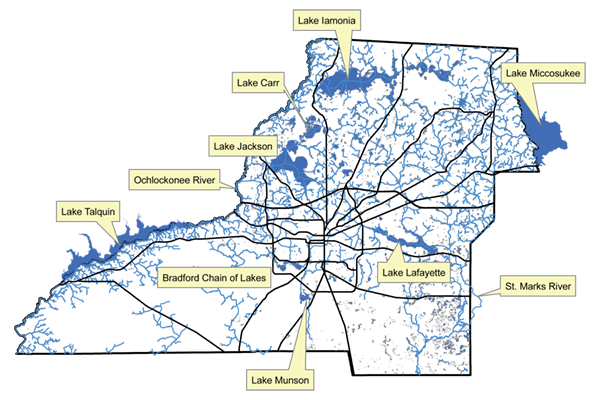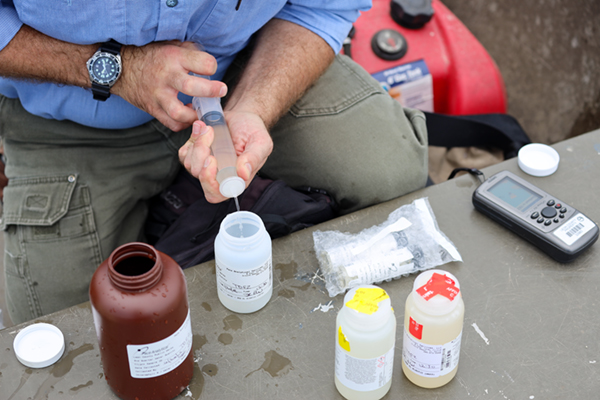Water Quality Monitoring Program
Water quality refers to the biological, chemical and physical conditions of a waterbody. Leon County's Water Quality Monitoring Program demonstrates our ongoing efforts as a responsible environmental steward of our natural resources and environmental beauty. The program includes quarterly water quality sampling and annual sediment and biological assessments of 13 lakes, 27 streams and 2 river systems for a total of 73 stations.
Leon County's Water Quality Monitoring Program:
- Assesses the long term health of our waters;
- Identifies lakes, streams and rivers with potential water quality problems;
- Meets our National Pollutant Discharge Elimination System (NPDES) permit requirements; and
- Monitors the effects of management programs.
The program data allows the County to monitor the ecosystem health of the lakes, streams and rivers of Leon County. Quarterly data on approximately 39 water quality parameters at each of our water monitoring stations is collected by certified County staff and analyzed by laboratories that are accredited through the National Environmental Laboratory Accreditation Program (NELAP). After collection, the data is entered into the Florida Watershed Information Network (WIN) database for use by local, state and federal agencies.

Through the Water Quality Monitoring Program, Leon County is able to monitor ecosystem health, identify effective means of stormwater management, guide appropriate land use decisions, contribute to the Florida Department of Environmental Protection's database, refine state water quality criteria and document waterbody conditions for Total Maximum Daily Load (TMDL) and Basin Management Action Plan (BMAP) consideration.
Leon County's Interactive Water Quality Map allows citizens to view the County's water bodies and their respective water quality reports. This long-term data is critical to identify trends in waterbody health.
Type of Information Collected
Water Chemistry
The current program collects quarterly data on 39 water chemistry parameters at each of the stations. The annual lake sediment analysis involves six laboratory parameters. More information on other factors that can influence water chemistry, including algal blooms, as well as information regarding fish consumption advisories can be found on this site.

Biological Monitoring
In addition to assessing water chemistry, Leon County uses biological indices to evaluate the health of our streams. This allows us to study past conditions as well as current conditions and look at changes over time, rather than only relying on chemical and physical data that was collected during a time in which a sample was taken. Water pollution is recognized as a biological problem, which occurs when human actions adversely impact a water system. One problem of relying solely on chemical and physical measurements to evaluate water quality is that they provide data that primarily reflect conditions that exist when the sample is taken, essentially providing a "snapshot" of water quality conditions. In an adversely impacted water system, biological populations change, pollution-sensitive animals disappear, other types and numbers of animals decrease, food webs become disturbed and undesirable nuisance species may dominate.
Stream Condition Index
Leon County uses the Florida Stream Condition Index as well as the Florida Habitat Assessment to help determine the health of streams. The Stream Condition Index assesses the biological health of stream ecosystems through the evaluation of the number and diversity of macroinvertibrates (Ex: flatworms, crayfish, snails, clams, insects etc.) living in a stream or river. Several factors, including sedimentation, pollution and habitat loss can negatively impact the health of a stream ecosystem. Biological assessments are necessary to document waterbody conditions for potential Total Maximum Daily Load (TMDL) consideration, identify the most effective means of stormwater management and guide appropriate land use decisions.
Habitat Assessment
Leon County makes an assessment on the health of water body's habitat using established characteristics and assigns an overall habitat score that is either optimal, suboptimal, marginal or poor. These characteristics include: substrate diversity, substrate availability, water velocity, habitat smothering, artificial channelization, bank stability, riparian buffer zone width and riparian zone vegetation quality.
Lake Vegetation Index
The Lake Vegetation Index (LVI) is a multi-metric index that evaluates how closely a lake’s plant community resembles one which would be expected in a condition of minimal human disturbance. It is based on a rapid field assessment of how aquatic and wetland plants are impacted by human disturbance over time. Plants respond to physical disturbances such as introduction of exotic species or lakeshore alterations, and chemical disturbances such as introduction of excess nutrients, particulates or herbicides from surrounding areas. More information regarding the LVI can be found here. Results for LVIs most recently conducted can be found here.

Water Quality Issues in Leon County
In general, Leon County faces many of the same water quality issues that impact communities across the United States as identified by the Environmental Protection Agency's National Summary of Impaired Waters.
In Leon County, water quality issues are often associated with nonpoint source pollution and changes in the watershed's hydrology. Water quality issues caused by nonpoint source pollution include excess nutrients and bacteria. An increase in bacterial levels, typically coliform-type bacteria, can lead to public health concerns and beach closings. Changes in the watershed's hydrology, such as increased non-porous surfaces, channel modification, filling of wetlands and excessive erosion caused by poor land management impact water quality by increasing the volume, velocity and temperature of runoff and altering the habitat of fish and other aquatic life.
Impact of Leon County's Water Quality Monitoring Program
In monitoring water quality issues, Leon County can identify trends and adjust its series of policies, regulations and standard operating procedures that work on reducing the impacts of nonpoint source pollution and minimize negative impacts on our water bodies. Monitoring may demonstrate the benefits of capital projects and nonstructural efforts to reduce pollutant loads to all waterbodies, or monitoring may show where targeted improvements might be made. Leon County's Water Quality Monitoring Program continues to serve as a key component of the County's environmental stewardship efforts by identifying areas in need of attention and providing documented and verified results of improvements in water quality.
For copies of previous years' reports, to access additional water quality data, or for any questions relating to the water quality sampling program, please contact Johnny Richardson, Water Resource Scientist, at (850) 606-1500 or at Richardsonjo@LeonCountyFL.gov.